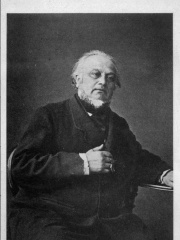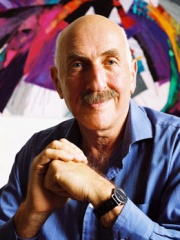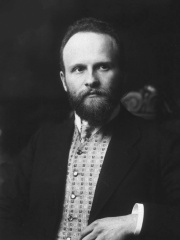
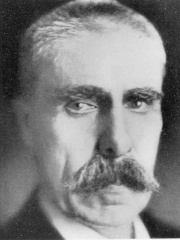
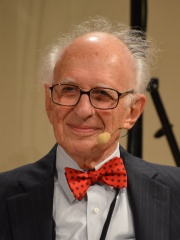
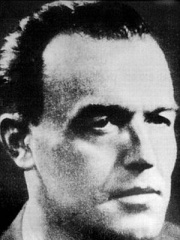

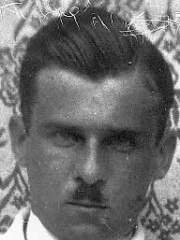
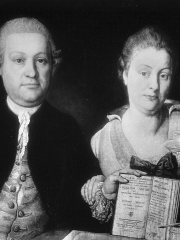
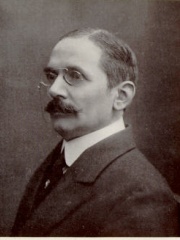
The Most Famous
PHYSICIANS from Austria
This page contains a list of the greatest Austrian Physicians. The pantheon dataset contains 726 Physicians, 12 of which were born in Austria. This makes Austria the birth place of the 14th most number of Physicians behind Russia, and India.
Top 10
The following people are considered by Pantheon to be the top 10 most legendary Austrian Physicians of all time. This list of famous Austrian Physicians is sorted by HPI (Historical Popularity Index), a metric that aggregates information on a biography's online popularity. Visit the rankings page to view the entire list of Austrian Physicians.

1. Róbert Bárány (1876 - 1936)
With an HPI of 77.51, Róbert Bárány is the most famous Austrian Physician. His biography has been translated into 66 different languages on wikipedia.
Robert Bárány (Hungarian: Bárány Róbert, pronounced [ˈbaːraːɲ ˈroːbɛrt]; 22 April 1876 – 8 April 1936) was an Austrian-born otologist. He received the 1914 Nobel Prize in Physiology or Medicine for his work on the physiology and pathology of the vestibular apparatus.

2. Julius Wagner-Jauregg (1857 - 1940)
With an HPI of 72.48, Julius Wagner-Jauregg is the 2nd most famous Austrian Physician. His biography has been translated into 59 different languages.
Julius Wagner-Jauregg (German: [ˈjuːli̯ʊs ˈvaːɡnɐ ˈjaʊʁɛk]; 7 March 1857 – 27 September 1940) was an Austrian physician, who won the Nobel Prize in Physiology or Medicine in 1927, and is the first psychiatrist to have done so. His Nobel award was "for his discovery of the therapeutic value of malaria inoculation in the treatment of dementia paralytica".

3. Eric Kandel (b. 1929)
With an HPI of 70.78, Eric Kandel is the 3rd most famous Austrian Physician. His biography has been translated into 52 different languages.
Eric Richard Kandel (German: [ˈkandəl]; born Erich Richard Kandel, November 7, 1929) is an Austrian-born American medical doctor who specialized in psychiatry. He was also a neuroscientist and a professor of biochemistry and biophysics at the College of Physicians and Surgeons at Columbia University. He was a recipient of the 2000 Nobel Prize in Physiology or Medicine for his research on the physiological basis of memory storage in neurons. He shared the prize with Arvid Carlsson and Paul Greengard. Kandel was from 1984 to 2022 a Senior Investigator in the Howard Hughes Medical Institute. He was in 1975 the founding director of the Center for Neurobiology and Behavior, which is now the Department of Neuroscience at Columbia University. He currently serves on the Scientific Council of the Brain & Behavior Research Foundation. Kandel's popularized account chronicling his life and research, In Search of Memory: The Emergence of a New Science of Mind, was awarded the 2006 Los Angeles Times Book Prize for Science and Technology.

4. Aribert Heim (1914 - 1992)
With an HPI of 70.30, Aribert Heim is the 4th most famous Austrian Physician. His biography has been translated into 35 different languages.
Aribert Ferdinand Heim (28 June 1914 – 10 August 1992), also known as Dr. Death and Butcher of Mauthausen, was an Austrian Schutzstaffel (SS) doctor. During World War II, he served at the Mauthausen-Gusen concentration camp in Mauthausen, killing and torturing inmates using various methods, such as the direct injection of toxic compounds into the hearts of his victims. After the war, Heim lived in Cairo, Egypt, under the alias of Tarek Farid Hussein after his conversion to Islam. In February 2009, after years of attempts to locate him, German television network ZDF had found Heim's passport and other documents in Cairo. It was then reported that Heim had died there on 10 August 1992 from complications of rectal cancer, according to testimony by his son Ruediger and lawyer. This information, though set forth by a German court, was questioned by Efraim Zuroff, a leading Nazi hunter of the Simon Wiesenthal Center. Zuroff stated that on a visit to Puerto Montt, Chile, in July 2008, Heim's daughter told him that Heim had died in 1993 in Argentina. In 2012, a court in Baden-Baden confirmed again that Heim had died in 1992 in Egypt, based on new evidence provided by his family and lawyer. The Wiesenthal Center continued to dispute these findings, and Heim remained on the list of most-wanted Nazi war criminals until 2013.
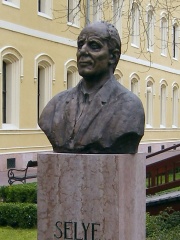
5. Hans Selye (1907 - 1982)
With an HPI of 70.17, Hans Selye is the 5th most famous Austrian Physician. His biography has been translated into 30 different languages.
János Hugo Bruno "Hans" Selye (; Hungarian: Selye János Hungarian pronunciation: [ˈʃɛjɛ]; January 26, 1907 – October 16, 1982) was a Hungarian-Canadian endocrinologist who conducted important scientific work on the hypothetical non-specific response of an organism to stressors. Although he did not recognize all of the many aspects of glucocorticoids, Selye was aware of their role in the stress response.

6. Hans Asperger (1906 - 1980)
With an HPI of 69.61, Hans Asperger is the 6th most famous Austrian Physician. His biography has been translated into 44 different languages.
Johann Friedrich Karl Asperger (; German: [ˈhans ˈaspɛɐ̯ɡɐ]; 18 February 1906 – 21 October 1980) was an Austrian physician. Noted for his early studies on atypical neurology, specifically in children, he is the namesake of the former autism spectrum disorder, Asperger syndrome. He wrote more than 300 publications on psychological disorders that posthumously acquired international renown in the 1980s. His diagnosis of autism, which he termed "autistic psychopathy", garnered controversy. Further controversy arose in the late 2010s over allegations that Asperger referred children to the Am Spiegelgrund children's clinic in Vienna during the Nazi period. The clinic was responsible for murdering hundreds of disabled children deemed to be "unworthy of life" as part of the Third Reich's child euthanasia programs (as part of the T4 Programme), although the extent of Asperger's knowledge of this fact and his intentions in referring patients to the clinic remain yet to be ascertained.

7. Irmfried Eberl (1910 - 1948)
With an HPI of 63.73, Irmfried Eberl is the 7th most famous Austrian Physician. His biography has been translated into 17 different languages.
Irmfried Eberl (8 September 1910 – 16 February 1948) was an Austrian psychiatrist and medical director of the euthanasia institutes in Brandenburg and Bernburg, who helped set up and was the first commandant of the Treblinka extermination camp where he worked as SS-Obersturmführer from 11 July 1942 until his dismissal on 26 August 1942. He was arrested after the end of the war in January 1948. Eberl hanged himself the following month to avoid trial.

8. Leopold Auenbrugger (1722 - 1809)
With an HPI of 63.45, Leopold Auenbrugger is the 8th most famous Austrian Physician. His biography has been translated into 20 different languages.
Josef Leopold Auenbrugger or Avenbrugger (19 November 1722 – 17 May 1809), also known as Leopold von Auenbrugger, was an Austrian physician who invented percussion as a diagnostic technique. On the strength of this discovery, he is considered one of the founders of modern medicine.

9. Victor Babeș (1854 - 1926)
With an HPI of 62.44, Victor Babeș is the 9th most famous Austrian Physician. His biography has been translated into 24 different languages.
Victor Babeș (Romanian pronunciation: [ˈviktor ˈbabeʃ]; 28 July 1854 in Vienna – 19 October 1926 in Bucharest) was a Romanian physician, bacteriologist, academician and professor. One of the founders of modern microbiology, Victor Babeș is the author of one of the first treatises of bacteriology in the world – Bacteria and their role in pathological anatomy and histology of infectious diseases, written in collaboration with French scientist Victor André Cornil in 1885. In 1888, Babeș underlined the principle of passive immunity, and a few years later he enunciated the principle of antibiosis. He made early and significant contributions to the study of rabies, leprosy, diphtheria, tuberculosis and other infectious diseases. He also discovered more than 50 unknown germs and foresaw new methods of staining bacteria and fungi. Victor Babeș introduced rabies vaccination and founded serotherapy in Romania. Babeș-Bolyai University in Cluj-Napoca and the University of Medicine and Pharmacy in Timișoara bear his name.
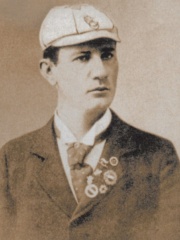
10. Paul Neumann (1875 - 1932)
With an HPI of 62.14, Paul Neumann is the 10th most famous Austrian Physician. His biography has been translated into 26 different languages.
Paul Neumann (13 June 1875 in Vienna – 9 February 1932) was an Austrian swimmer and physician, who competed at the 1896 Summer Olympics in Athens and became the first ever Austrian gold medalist.
People
Pantheon has 12 people classified as Austrian physicians born between 1722 and 1932. Of these 12, 1 (8.33%) of them are still alive today. The most famous living Austrian physicians include Eric Kandel. The most famous deceased Austrian physicians include Róbert Bárány, Julius Wagner-Jauregg, and Aribert Heim.
Living Austrian Physicians
Go to all RankingsDeceased Austrian Physicians
Go to all RankingsRóbert Bárány
1876 - 1936
HPI: 77.51
Julius Wagner-Jauregg
1857 - 1940
HPI: 72.48
Aribert Heim
1914 - 1992
HPI: 70.30
Hans Selye
1907 - 1982
HPI: 70.17
Hans Asperger
1906 - 1980
HPI: 69.61
Irmfried Eberl
1910 - 1948
HPI: 63.73
Leopold Auenbrugger
1722 - 1809
HPI: 63.45
Victor Babeș
1854 - 1926
HPI: 62.44
Paul Neumann
1875 - 1932
HPI: 62.14
Bénédict Morel
1809 - 1873
HPI: 59.56
Fritz Klein
1932 - 2006
HPI: 58.33
Overlapping Lives
Which Physicians were alive at the same time? This visualization shows the lifespans of the 11 most globally memorable Physicians since 1700.

